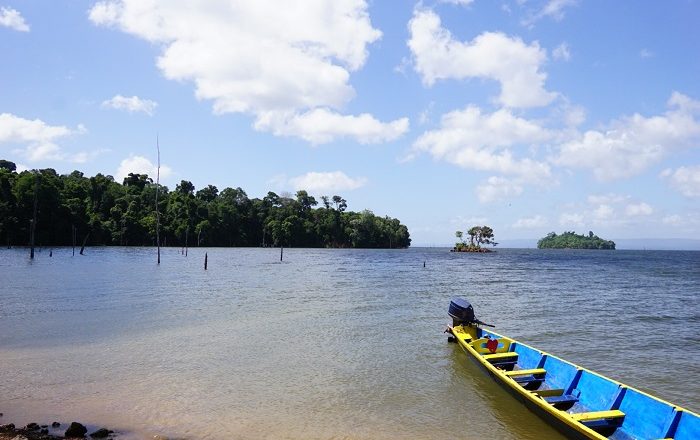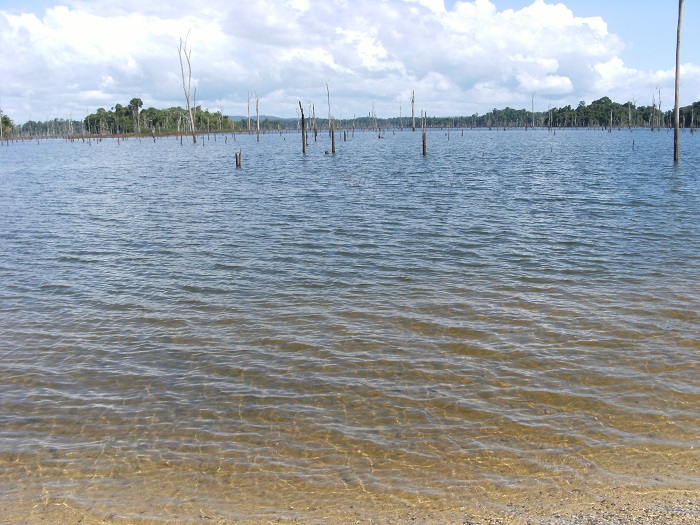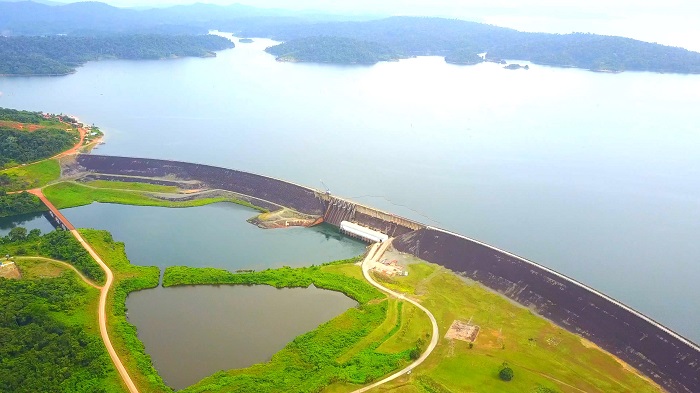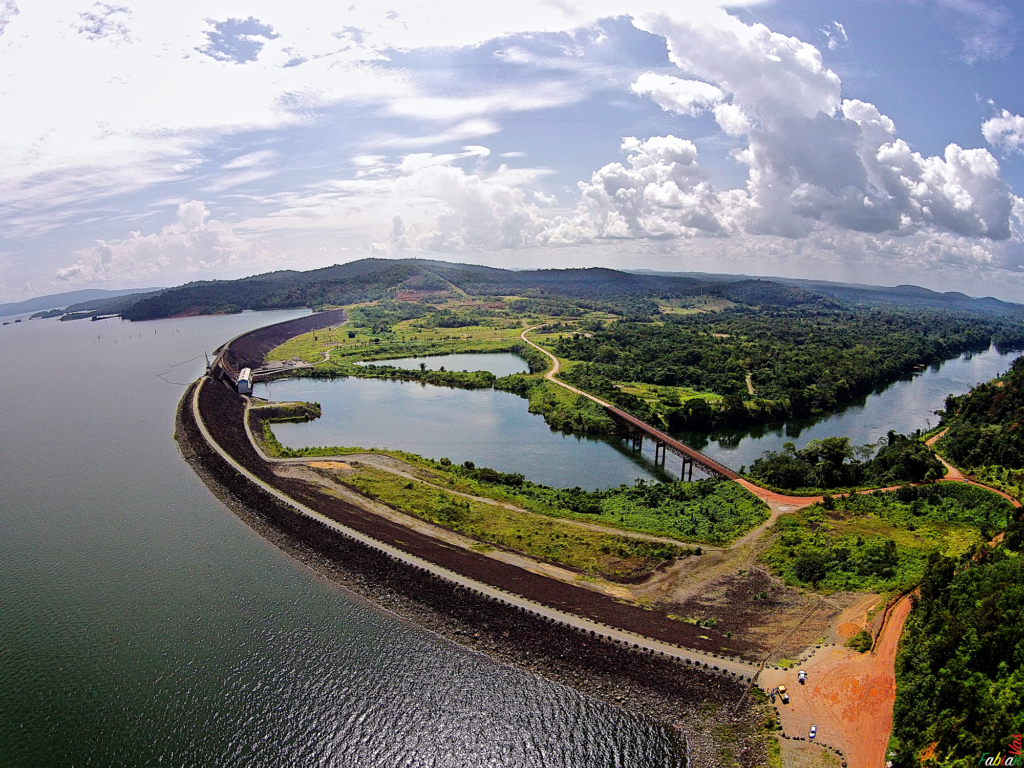So, have you ever heard of the Brokopondo Reservoir? It’s this massive, man-made lake located in Suriname, which happens to be the largest lake in the entire country. Pretty cool, right? Well, buckle up because we’re about to dive into the fascinating world of this amazing body of water.
Let me tell you, the Brokopondo Reservoir is no ordinary lake. It was created back in the 1960s as part of a hydroelectric project. They built a dam on the Suriname River, blocking its flow and flooding the surrounding area to create this massive reservoir. Now, it spans over 1350 square kilometers and holds an impressive amount of water.
But here’s the thing – the Brokopondo Reservoir isn’t just a pretty sight. It actually serves a very important purpose. You see, it generates hydroelectric power for Suriname, supplying energy to both industrial and residential areas. It’s a vital source of electricity for the country, and it’s also a popular spot for fishing and water sports. So, in our upcoming article, we’ll be diving into the history, significance, and beauty of this amazing lake. Stay tuned to learn more about the Brokopondo Reservoir and why it’s a must-visit destination in Suriname!

1. History of the Brokopondo Reservoir
1.1 Construction of the Reservoir
The construction of the Brokopondo Reservoir was a monumental project that started in the mid-1960s. It was a joint effort between the Surinamese government and Alcoa, an American aluminum company. The main purpose of building the reservoir was to provide a source of hydroelectric power to support the aluminum smelting industry. The Suriname Aluminum Company (Suralco), a subsidiary of Alcoa, played a significant role in the development and construction of the reservoir.
1.2 Displacement of Indigenous Communities
One of the unfortunate consequences of building the Brokopondo Reservoir was the displacement of indigenous communities. Several villages, including their homes and ancestral lands, were flooded to create the reservoir. The displaced communities, mainly from the Saamaka, Aukan, and Matawai tribes, had to be relocated to new settlements. The forced displacement and loss of their traditional territories had a profound impact on these indigenous communities, leading to significant social and cultural changes.
1.3 Impact on Biodiversity
The creation of the Brokopondo Reservoir also had a substantial impact on the region’s biodiversity. The flooding of large areas of land resulted in the loss of important wildlife habitats and altered local ecosystems. Many plant and animal species that were endemic to the area faced challenges in adapting to the new environment. However, over time, new ecosystems have developed around the reservoir, supporting a diverse range of flora and fauna.
2. Geographical Features of the Brokopondo Reservoir
2.1 Location and Size
The Brokopondo Reservoir is located in the central part of Suriname, South America. It spans an area of approximately 1,560 square kilometers, making it the largest lake in the country. The reservoir is nestled within the vast verdant rainforests of the Surinamese interior, adding to its breathtaking natural beauty.
2.2 Formation and Purpose
The reservoir was formed by damming the Suriname River, which led to the creation of a massive body of water. The dam, officially known as the Afobaka Dam, stands at an impressive height of 54 meters. The primary purpose of constructing the reservoir was to generate hydroelectric power to fuel the aluminum smelting industry. The Suriname Aluminum Company’s operations heavily rely on the energy harnessed from the reservoir.

3. Flora and Fauna in and around the Reservoir
3.1 Aquatic Plant Life
The Brokopondo Reservoir is home to a rich variety of aquatic plant life. Water lilies, reeds, and floating grasses thrive in the calm waters, creating vibrant and picturesque scenes. These plants provide essential habitats and food sources for numerous aquatic species, contributing to the overall biodiversity of the reservoir.
3.2 Fish Species
The reservoir serves as a haven for numerous fish species, attracting anglers from around the world. Some of the common fish species found in the Brokopondo Reservoir include peacock bass, piraiba catfish, and tucunaré. These fish have adapted well to the reservoir’s environment and have become popular targets for sport fishing enthusiasts.
3.3 Bird Species
The Brokopondo Reservoir is also a paradise for birdwatchers. Over 200 bird species have been recorded in the area, ranging from majestic raptors like the harpy eagle to colorful parrots and toucans. The abundance of fish in the reservoir attracts various aquatic birds such as herons, kingfishers, and cormorants.
3.4 Mammals
The surrounding rainforests provide a habitat for a diverse range of mammal species. Some of the notable mammal species that can be spotted near the reservoir include capybaras, spider monkeys, and giant river otters. These charismatic animals contribute to the overall ecological value of the area and provide opportunities for wildlife enthusiasts to observe them in their natural habitat.
3.5 Reptiles and Amphibians
The Brokopondo Reservoir and its surrounding areas are also home to numerous reptile and amphibian species. Spectacular caiman, which are large crocodilian reptiles, can be found basking in the sun near the water’s edge. Tree frogs, poison dart frogs, and various snake species add to the vibrant and diverse ecosystem of the reservoir.
4. Recreational Activities and Attractions
4.1 Fishing Opportunities
The Brokopondo Reservoir is a haven for fishing enthusiasts. Its vast waters offer excellent opportunities for sport fishing, with various species available all year round. Anglers can try their luck in catching trophy fish such as peacock bass and piraiba catfish. The reservoir’s calm and serene atmosphere also adds to the overall fishing experience.
4.2 Boating and Water Sports
The expansive Brokopondo Reservoir provides the perfect setting for boating and water sports activities. Visitors can explore the reservoir’s pristine waters by renting boats or enjoying a peaceful kayak ride. The calm nature of the reservoir makes it suitable for water sports like paddleboarding and windsurfing, attracting adventure seekers from all over.
4.3 Wildlife Watching
The diverse range of flora and fauna around the Brokopondo Reservoir makes it an ideal destination for wildlife watching. Visitors can embark on guided tours or hike along designated trails to observe the rich biodiversity of the area. From colorful birds to fascinating mammals, the reservoir offers a unique opportunity to connect with nature and witness its wonders firsthand.
4.4 Camping and Picnicking
For those seeking a more immersive experience, camping and picnicking facilities are available near the reservoir. Camping grounds with basic amenities allow visitors to spend a night under the stars, surrounded by the tranquil beauty of the reservoir. Picnic areas provide the perfect spots for families and friends to enjoy a day out in nature, with scenic views as a backdrop.

5. Environmental Concerns and Conservation Efforts
5.1 Water Quality and Pollution
One of the ongoing environmental concerns surrounding the Brokopondo Reservoir is the water quality. The accumulation of sediment from deforestation and agricultural activities in the reservoir’s watershed can lead to increased turbidity and nutrient runoff, affecting the overall health of the ecosystem. Efforts are being made to monitor and control pollution levels to ensure the long-term sustainability of the reservoir.
5.2 Deforestation and Erosion
The surrounding rainforests play a crucial role in maintaining the ecological balance of the Brokopondo Reservoir. However, deforestation for logging and agricultural purposes puts immense pressure on these forests. Clearing land for plantations and illegal gold mining can lead to increased erosion and sedimentation, negatively impacting the reservoir’s water quality and aquatic life.
5.3 Protection of Endangered Species
Conservation efforts are being undertaken to protect endangered species that inhabit the Brokopondo Reservoir and its surrounding areas. Strict measures are implemented to safeguard species such as the giant river otter and harpy eagle, ensuring their habitats remain intact and their populations can flourish.
5.4 Sustainable Development Initiatives
Various sustainable development initiatives are being implemented to address the environmental concerns associated with the Brokopondo Reservoir. These initiatives focus on promoting responsible tourism, supporting local communities, and raising awareness about the importance of conservation. By integrating sustainable practices into development plans, the reservoir can be managed in a way that ensures both its ecological integrity and societal benefits.
6. Socio-economic Impact of the Brokopondo Reservoir
6.1 Hydroelectric Power Generation
The Brokopondo Reservoir has played a significant role in Suriname’s energy production. The hydropower generated from the reservoir’s Afobaka Dam supplies electricity to various industries and communities across the country. The stable power supply has contributed to economic growth and improved living standards for Surinamese citizens.
6.2 Economic Development
The construction and operation of the Brokopondo Reservoir have led to significant economic development in the surrounding regions. The reservoir has created employment opportunities, particularly in the energy and tourism sectors. Furthermore, the availability of abundant water resources has facilitated agricultural activities, supporting the local economy.
6.3 Tourism and Local Businesses
The allure of the Brokopondo Reservoir has attracted tourists from far and wide. The influx of visitors has resulted in the growth of tourism-related businesses, including accommodations, restaurants, and tour operators. These enterprises provide income for local communities and contribute to the overall economic prosperity of the region.

7. Indigenous Communities and Cultural Heritage
7.1 Displacement and Resettlement
The construction of the Brokopondo Reservoir had severe consequences for indigenous communities living in the area. The forced displacement of these communities from their ancestral lands to make way for the reservoir caused social disruptions and cultural loss. Efforts have been made to address the challenges faced by these communities and ensure their voices are heard in decision-making processes.
7.2 Preservation of Indigenous Culture
Despite the challenges faced by indigenous communities, there are ongoing efforts to preserve their cultural heritage. Traditional practices, rituals, and storytelling are being passed down to younger generations, ensuring the continuity of indigenous culture. Collaborative initiatives between indigenous communities and external agencies aim to promote the appreciation and understanding of these rich cultural traditions.
7.3 Traditional Practices and Artifacts
The Brokopondo Reservoir region is home to diverse indigenous communities, each with their own unique traditional practices and artifacts. Visitors have the opportunity to learn about and appreciate these cultural treasures through community-led tours and educational programs. Handcrafted artifacts, such as pottery and textiles, showcase the indigenous communities’ artistic skills and their deep connection to the land.
8. Challenges and Future Prospects
8.1 Balancing Economic Growth and Environmental Conservation
One of the main challenges facing the Brokopondo Reservoir is finding a balance between economic development and environmental conservation. It is essential to ensure that the reservoir’s natural resources are managed sustainably to prevent irreversible damage to the surrounding ecosystems. By adopting responsible practices and incorporating environmental considerations into development plans, Suriname can continue to benefit from the reservoir while preserving its ecological integrity.
8.2 Sustainable Management of the Reservoir
Sustainable management of the Brokopondo Reservoir is crucial for its long-term viability. This includes measures to mitigate pollution, control sedimentation, and protect endangered species. By implementing effective monitoring programs and involving local communities in decision-making processes, the reservoir can be managed in a way that promotes its ecological health and supports the needs of surrounding communities.
8.3 Collaboration with International Organizations
Collaboration with international organizations can provide valuable support and expertise in managing the Brokopondo Reservoir sustainably. These partnerships can facilitate knowledge sharing, capacity building, and access to funding for conservation and development projects. By engaging with international stakeholders, Suriname can benefit from global best practices and ensure the reservoir’s future prospects are optimized.

9. Research and Scientific Discoveries
9.1 Study of Aquatic Ecosystems
Scientific research in and around the Brokopondo Reservoir has been instrumental in expanding our understanding of aquatic ecosystems. Studies on water quality, fish populations, and the impact of human activities have provided valuable insights for sustainable management practices. Ongoing research continues to shed light on the complexities of the reservoir’s ecological dynamics and informs conservation efforts.
9.2 Impact of the Reservoir on Climate
The creation of the Brokopondo Reservoir also has implications for regional climate patterns. The accumulation of large bodies of water and the alteration of land cover may influence local weather patterns and rainfall distribution. Studying the climate effects of the reservoir contributes to a more comprehensive understanding of the region’s climate system and provides insights into climate change adaptation strategies.
9.3 Archaeological and Paleontological Exploration
The flooding of large areas for the Brokopondo Reservoir has inadvertently created opportunities for archaeological and paleontological exploration. Submerged forests and archaeological sites have been discovered along the reservoir’s shoreline, offering valuable insights into the region’s past. Exploration and study of these submerged landscapes contribute to our understanding of Suriname’s history and the natural processes that have shaped the landscape.
10. Infrastructure and Transportation
10.1 Roads and Bridges
Infrastructure development has been crucial in facilitating access to the Brokopondo Reservoir and its surrounding areas. Well-maintained roads and bridges provide convenient transportation routes for visitors, allowing them to explore the reservoir and access nearby attractions. These infrastructure improvements also benefit local communities, enabling them to connect with urban centers and markets more efficiently.
10.2 Boating Routes
The Brokopondo Reservoir offers excellent opportunities for boating and navigating its vast waters. Boating routes have been established, guiding visitors through the reservoir’s main channels and highlighting key points of interest. Signage and navigational aids enhance boaters’ safety and ensure a pleasant and enjoyable experience while exploring the reservoir.
10.3 Accessibility to Surrounding Areas
Efforts have been made to improve accessibility to the surrounding areas of the Brokopondo Reservoir. Well-planned trails and paths allow visitors to hike through the rainforest and explore its wonders. Accessibility has been optimized to ensure that visitors can appreciate the beauty and biodiversity of the region while minimizing negative impacts on the ecosystem.
11. Government Policies and Regulations
11.1 Environmental Protection Laws
The Surinamese government has implemented environmental protection laws to safeguard the Brokopondo Reservoir and its surrounding ecosystems. These laws outline regulations for land use, pollution control, and conservation efforts. Compliance with these laws is crucial to ensure the long-term sustainability of the reservoir and the preservation of its natural heritage.
11.2 Licensing and Permit Requirements
To maintain responsible tourism and development practices, the government has put in place licensing and permit requirements for activities related to the Brokopondo Reservoir. These requirements ensure that individuals and businesses adhere to environmental standards and demonstrate their commitment to the sustainable management of the reservoir.
11.3 Monitoring and Enforcement
Monitoring and enforcement of regulations are crucial to ensure the effectiveness of government policies and regulations. Surveillance systems, patrols, and community-based monitoring programs are essential tools in detecting and preventing illegal activities that may harm the reservoir’s ecosystem. By upholding monitoring and enforcement efforts, the government can preserve the long-term ecological integrity of the Brokopondo Reservoir.
12. Educational and Awareness Programs
12.1 Environmental Education
Education is crucial in fostering environmental awareness and promoting responsible behavior towards the Brokopondo Reservoir. Environmental education programs for schools and communities contribute to building a generation of individuals who appreciate and understand the value of the reservoir. These programs instill a sense of stewardship and empower individuals to take positive actions for environmental conservation.
12.2 Community Outreach
Community outreach programs play a pivotal role in engaging local communities in the conservation and sustainable management of the Brokopondo Reservoir. These programs provide platforms for dialogue, knowledge sharing, and capacity building. By involving local communities in decision-making processes, their perspectives and traditional knowledge can be integrated into management strategies effectively.
12.3 Public Awareness Campaigns
Public awareness campaigns raise the profile of the Brokopondo Reservoir and its importance both locally and internationally. These campaigns aim to highlight the ecological value of the reservoir and the need for responsible tourism and development practices. By raising awareness, individuals and businesses can make informed decisions that contribute to the long-term sustainability of the reservoir.
13. Collaboration and Partnerships
13.1 Involvement of Local NGOs
Local non-governmental organizations (NGOs) play a crucial role in the conservation and sustainable management of the Brokopondo Reservoir. These organizations work closely with communities, the government, and other stakeholders to implement projects and initiatives that address environmental concerns. Their involvement ensures a holistic and community-driven approach to the reservoir’s management.
13.2 Collaboration with International Organizations
Collaboration with international organizations brings valuable expertise and resources to support conservation efforts for the Brokopondo Reservoir. International partners provide financial assistance, technical support, and knowledge sharing platforms. These collaborations foster global cooperation in addressing environmental challenges and promote best practices in sustainable development.
13.3 Private-Public Partnerships
Public-private partnerships are instrumental in driving sustainable and responsible development around the Brokopondo Reservoir. Partnerships between private companies, government agencies, and local communities can contribute to the funding and implementation of conservation and development projects. Collaboration allows for the sharing of resources, expertise, and responsibilities, leading to more effective and impactful outcomes.
14. Conclusion
14.1 Key Takeaways
The Brokopondo Reservoir in Suriname is a remarkable testament to human ingenuity and the significant impact humans can have on the environment. The construction of the reservoir has resulted in both positive and negative consequences, from the displacement of indigenous communities to the economic development and tourism opportunities it has brought.
14.2 Future Prospects
The future of the Brokopondo Reservoir depends on responsible management practices that prioritize the long-term well-being of the ecosystem and the people who rely on it. By addressing environmental concerns, promoting sustainable development, and strengthening collaboration among stakeholders, the reservoir can thrive as a vibrant and resilient natural resource.
14.3 Importance of Sustainable Management
Sustainable management of the Brokopondo Reservoir is essential for preserving its ecological integrity and the livelihoods of surrounding communities. By embracing sustainable practices, embracing indigenous knowledge, and integrating environmental considerations into decision-making processes, Suriname can ensure that the reservoir continues to be a source of beauty, biodiversity, and prosperity for generations to come.